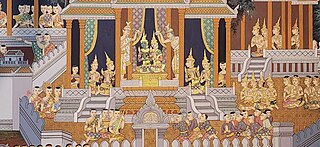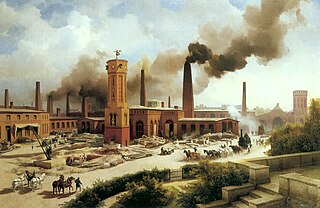
Rural flight is the migratory pattern of people from rural areas into urban areas. It is urbanization seen from the rural perspective.

The bourgeoisie is a class of business owners and merchants which emerged in the Late Middle Ages, originally as a "middle class" between peasantry and aristocracy. They are traditionally contrasted with the proletariat by their wealth, political power, and education, as well as their access to and control of cultural, social and financial capital.

A blue-collar worker is a working class person who performs manual labor or skilled trades. Blue-collar work may involve skilled or unskilled labor. The type of work may involve manufacturing, warehousing, mining, excavation, carpentry, electricity generation and power plant operations, electrical construction and maintenance, custodial work, farming, commercial fishing, logging, landscaping, pest control, food processing, oil field work, waste collection and disposal, recycling, construction, maintenance, shipping, driving, trucking, and many other types of physical work. Blue-collar work often involves something being physically built or maintained.

The middle class refers to a class of people in the middle of a social hierarchy, often defined by occupation, income, education, or social status. The term has historically been associated with modernity, capitalism and political debate. Common definitions for the middle class range from the middle fifth of individuals on a nation's income ladder, to everyone but the poorest and wealthiest 20%. Theories like "Paradox of Interest" use decile groups and wealth distribution data to determine the size and wealth share of the middle class.

The estates of the realm, or three estates, were the broad orders of social hierarchy used in Christendom from the Middle Ages to early modern Europe. Different systems for dividing society members into estates developed and evolved over time.

Petite bourgeoisie is a term that refers to a social class composed of semi-autonomous peasants and small-scale merchants. They are named as such because their politico-economic ideological stance in times of stability is reflective of the proper haute bourgeoisie. In regular times, the petite bourgeoisie seek to identify themselves with the haute bourgeoisie, whose bourgeois morality, conduct and lifestyle they aspire and strive to imitate.

Social stratification refers to a society's categorization of its people into groups based on socioeconomic factors like wealth, income, race, education, ethnicity, gender, occupation, social status, or derived power. As such, stratification is the relative social position of persons within a social group, category, geographic region, or social unit.
Social class is an important theme for historians of the United States for decades. The subject touches on many other elements of American history such as that of changing U.S. education, with greater education attainment leading to expanding household incomes for many social groups. The overall level of prosperity grew greatly in the U.S. through the 20th century as well as the 21st century, anchored in changes such as growing American advances in science and technology with American inventions such as the phonograph, the portable electric vacuum cleaner, and so on. Yet much of the debate has focused lately on whether social mobility has fallen in recent decades as income inequality has risen, what scholars such as Katherine S. Newman have called the "American nightmare."
The social structure of the United Kingdom has historically been highly influenced by the concept of social class, which continues to affect British society today. British society, like its European neighbours and most societies in world history, was traditionally divided hierarchically within a system that involved the hereditary transmission of occupation, social status and political influence. Since the advent of industrialisation, this system has been in a constant state of revision, and new factors other than birth are now a greater part of creating identity in Britain.

The social structure of China has an expansive history which begins from the feudal society of Imperial China to the contemporary era. There was a Chinese nobility, beginning with the Zhou dynasty. However, after the Song dynasty, the powerful government offices were not hereditary. Instead, they were selected through the imperial examination system, of written examinations based on Confucian thought, thereby undermining the power of the hereditary aristocracy.

The structure of social class in Cambodia has altered several times throughout its history. The traditional hereditary elites were marginalised in the 1970s, when military leaders gained prominence, before the Khmer Rouge attempted to dramatically eliminate existing class structures in the late 1970s. Since the emergence of peace in the early 1990s, social inequality has increased in Cambodia.
Marxian class theory asserts that an individual's position within a class hierarchy is determined by their role in the production process, and argues that political and ideological consciousness is determined by class position. A class is those who share common economic interests, are conscious of those interests, and engage in collective action which advances those interests. Within Marxian class theory, the structure of the production process forms the basis of class construction.
Economic restructuring is used to indicate changes in the constituent parts of an economy in a very general sense. In the western world, it is usually used to refer to the phenomenon of urban areas shifting from a manufacturing to a service sector economic base. It has profound implications for productive capacities and competitiveness of cities and regions. This transformation has affected demographics including income distribution, employment, and social hierarchy; institutional arrangements including the growth of the corporate complex, specialized producer services, capital mobility, informal economy, nonstandard work, and public outlays; as well as geographic spacing including the rise of world cities, spatial mismatch, and metropolitan growth differentials.
Belize's social structure is marked by enduring differences in the distribution of wealth, power, and prestige. Because of the small size of Belize's population and the intimate scale of social relations, the social distance between the rich and the poor, while significant, is nowhere as vast as in other Caribbean and Central American societies, such as Jamaica and El Salvador. Belize lacks the violent class and racial conflict that has figured so prominently in the social life of its Central American people.
A commoner, also known as the common man, commoners, the common people or the masses, was in earlier use an ordinary person in a community or nation who did not have any significant social status, especially a member of neither royalty, nobility, nor any part of the aristocracy. Depending on culture and period, other elevated persons may have had higher social status in their own right, or were regarded as commoners if lacking an aristocratic background.
Social classes in Italy are bourgeoisie, white-collar middle class, urban petite bourgeoisie, rural petite bourgeoisie, urban working class and rural working class.
Social classes in Iran have been divided up into upper class, propertied middle class, salaried middle class, working class, independent farmers, and rural wage earners. A more recent source divides Iranian classes into upper, middle class, working class, and lower class. Former Iranian President Mahmoud Ahmadinejad says 60 percent of his country's wealth is controlled by just 300 people in Iran. The gini coefficient was 0.38 in 2010 and the Human Development Index at 0.749 in 2013.

Bildungsbürgertum is a social class that emerged in mid-18th-century Germany, as the educated social stratum of the bourgeoisie, men and women who had received an education based upon the metaphysical values of Idealism and Classical studies of the Graeco–Roman culture of Antiquity. In sociological contrast to the Kleinbürgertum, the petite bourgeoisie of Germany, the Bildungsbürgertum were the intelligentsia and the upper economic-stratum of the German bourgeoisie.

The working class includes all employees who are compensated with wage or salary-based contracts. Working-class occupations include blue-collar jobs, and most pink-collar jobs. Members of the working class rely exclusively upon earnings from wage labour; thus, according to more inclusive definitions, the category can include almost all of the working population of industrialized economies, as well as those employed in the urban areas of non-industrialized economies or in the rural workforce.

Industrialization in Germany was the phase of the breakthrough of industrialization in Germany, beginning at the time from around 1815 to 1835. This period was preceded by the periods of pre-industrialization and early industrialization. In general, the decades between the 1830s and 1873 are considered the phase of industrial take off. The Industrial Revolution was followed by the phase of high industrialization during the German Empire. The (catch-up) Industrial Revolution in Germany differed from that of the pioneering country of Great Britain in that the key industries became not the textile industry but coal production, steel production and railroad construction.












